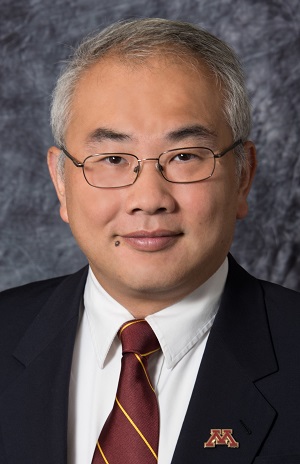
Convergence of technology, immunotherapy and courage help U of M patient rise above life-threatening brain tumor
In May 2018, 29-year-old Burnsville, MN, resident, Adam Donahue, began experiencing unusual symptoms. “I had numbness that ran all the way up my right side to the top of my head,” he said. An MRI confirmed the source of the numbness — glioblastoma, the same kind of aggressive brain tumor that took the lives of Senators John McCain and Ted Kennedy. “When you’re in your twenties, it’s not what you think you’ll go through,” said Adam’s wife, Angelica, tearfully. “It’s definitely been a tough time.”
But building on a foundation of his own indomitable spirit and courage, plus bleeding-edge surgical and therapeutic tools, Adam was given an opportunity few other glioblastoma patients have … to beat the odds.
Tumor grew, despite treatment
First, he went through radiation and chemotherapy, the standard treatment for glioblastoma. But the tumor continued growing, despite the therapeutic weapons being thrown at it. “It was disheartening when we saw that the treatment wasn’t doing what they thought it would do,” said Adam.
Because his brain could not tolerate more radiation and there was no other chemotherapy available, Adam seemed to be out of options – until he was referred to U of M Neurosurgery Department Head Clark C. Chen, MD, PhD. “Dr. Chen was so calm about everything,” said Angelica. “The way he explained things to us made us feel very comfortable.”
“He was super positive and reassuring but also very honest about what we could expect,” added Adam. “That’s very helpful as a patient.”
Candidate for DNAtrix clinical trial
When Chen reviewed the case, he thought Adam would be an excellent candidate for a clinical trial that he is leading at the U. The trial, known as DNAtrix, is a Phase 2, multi-center study exploring an innovative two-step treatment for glioblastoma. The first step is administering a genetically engineered virus called DNX-2401 directly into the tumor, followed by intravenous infusions of pembrolizumab, an immunotherapy known commercially as KEYTRUDA®.
DNX-2401 is a modified adenovirus – the virus that causes the common cold. It is engineered to specifically infect and replicate in brain cancer cells. As DNX-2401 replicates, it kills the tumor cells in ways that trigger the patient’s immune response against the tumor. The problem, according to Chen, is that glioblastomas have the ability to evade and “turn off” the patient’s immune system.
This is where KEYTRUDA comes in. KEYTRUDA acts by preventing glioblastoma's immune-suppressive ability. “The discovery of this drug is so revolutionary that the scientists who developed it were awarded the 2018 Nobel Prize in Physiology or Medicine,” noted Chen. “The combination of DNX-2401 and KEYTRUDA creates anti-tumor effects greater than those created by each component. DNX-2401 recruits immune cells to attack cancer cells, while KEYTRUDA shuts down glioblastoma’s ability to escape these immune attacks.”

Only at the University of Minnesota
To precisely deliver the virus into the tumor, Chen (pictured at left) used another advanced technology. “The virus is suspended in a liquid, and this liquid will flow down the path of least resistance,” Chen explained. “Because the tumor is pressurized with tightly packed cells, when you infuse the liquid containing the virus into the tumor, the liquid back flushes out into the space between the brain and the catheter, in the absence of technologies developed to specifically address this problem.”
To ensure that DNX-2401 is deposited within the tumor, Chen used a special catheter designed using nano-technology. “The catheter employs a series of gradually narrowing step-offs to prevent the liquid virus from back flushing,” Chen said. “And because the procedure is done inside the MRI, we can see precisely where the virus is deposited.” University of Minnesota is the first and only institution in Minnesota offering this treatment.
The convergence of genetic engineering, Nobel-prize winning immunotherapy, nanotechnology, and cutting-edge neurosurgery led to Adam’s tumor shrinking to a quarter of its original size and the continual lessening of his symptoms. “When we work together … the engineers who developed the nanotechnology cannula, the scientists who developed the drug and the virus, and the clinicians who did the surgery … when we put all that together with a courageous patient who believes in himself, we give birth to tomorrow’s neurosurgery,” said Chen.
Life-altering process
The rollercoaster ride that Adam and Angelica have been on throughout this process has changed their lives. “We’ve had our ups and downs and the downs have been very tough, but it was great to hear that something worked, something got us going in the right direction,” Adam said. “It changed my perspective about what is most important in my life. Now, I just want to spend time with my family, my nieces and my nephew, golf, and be with friends.”
Angelica explained that she had a special role during all this. “If Adam needed a break and couldn’t do something, I had to be his voice,” she said. “After going to an appointment, Adam would sometimes ask, ‘What did they talk about?’ I had to be that voice, too. To be positive. To do my research and be as informed as I could. As Adam’s primary caregiver, he obviously turns to me for advice.”
“About everything is more like it,” Adam added. “I’m also lucky to have the rest of my family close to the Twin Cities. You need to have that support system.”
Beating the odds
According to Chen, Adam’s prognosis is improbably positive. “I’ve seen this kind of response in a limited number of patients,” he said. “I called Adam the moment I saw the MRI!!! Many give up on glioblastoma patients because they respond poorly to therapy, but with the confluence of new technology, dedicated physicians, and courageous patients, we can and will change that.”
If you would like more information about the U of M DNAtrix trial, please contact Felicia O’Neil at foneill@umn.edu



